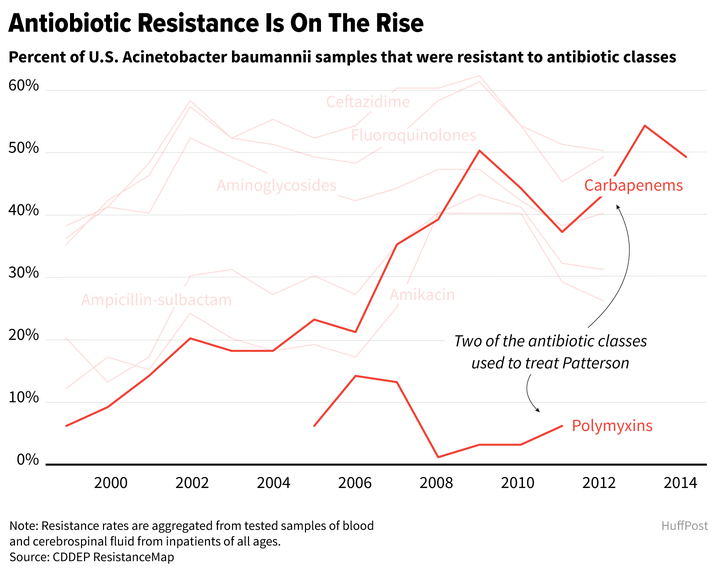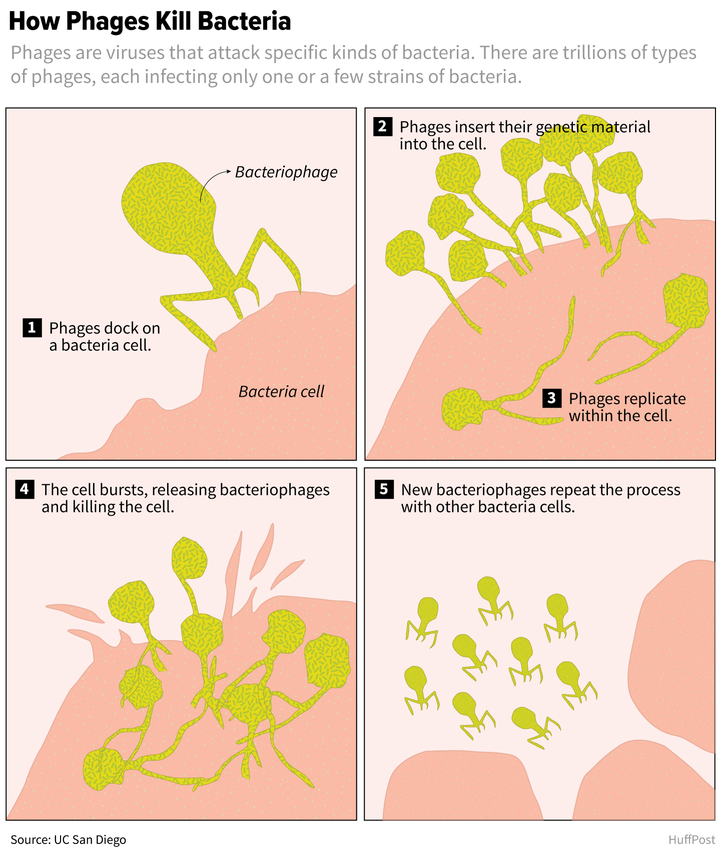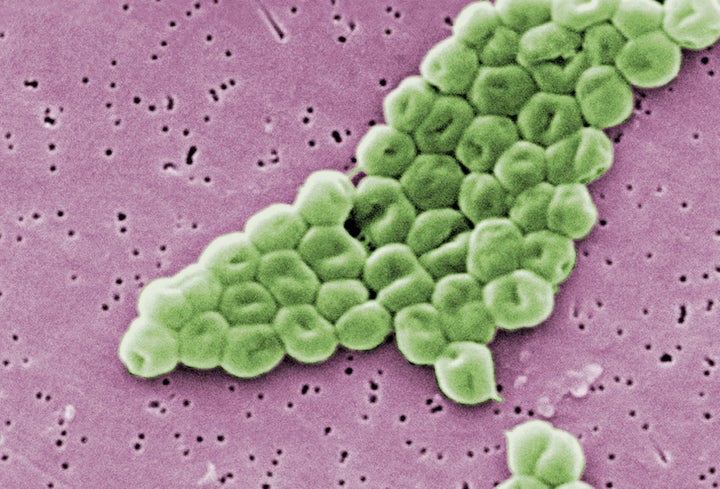Lauren Weber, Huffington Post (May 11, 2017)
Bacteriophages — viruses found in soil, water and human waste — may be the cure in a post-antibiotic world.
When Thomas Patterson woke up from a two-month coma in March 2016, he learned two things he couldn’t believe: Donald Trump was soon to become the Republican nominee for president, and his wife, Steffanie Strathdee, had saved him from dying of an antibiotic-resistant superbug by injecting him with viruses harvested from sewage.
It took a lot of convincing for him to accept these weren’t just more hallucinations.
Patterson and Strathdee met while serving on a National Institutes of Health grant review panel almost 16 years ago. Strathdee doesn’t usually find review panels a riveting experience, but when she caught Patterson’s eye, they both realized there might be something more to this one.
Married in 2004, they work together in the field of HIV/AIDS research at the University of California, San Diego ― Patterson as a professor of psychiatry at the School of Medicine, and Strathdee as an infectious disease epidemiologist and head of the Global Health Institute.
They’re also avid travelers who have visited more than 50 countries. They added Egypt to their list in November 2015 and found themselves thrust into another global health crisis. But this time, Patterson was the patient, and his case could prove to be a medical turning point.

On Nov. 28, 2015, Patterson started having terrible stomach pain and running a fever. Originally the couple thought he had food poisoning. They headed to a clinic in Luxor, Egypt, where doctors diagnosed him with pancreatitis and began treatment.
Patterson’s symptoms kept getting worse. After less than a week, he was medevaced to a hospital in Frankfurt, Germany, where doctors determined that he had a life-threatening infection from a multidrug-resistant strain of Acinetobacter baumannii. Public health experts sometimes call multidrug-resistant bacteria “superbugs,” because they can’t be stopped by most antibiotics.
The superbug that Patterson contracted has also been dubbed “Iraqibacter,” because it was previously found in American soldiers who had served in the Iraq War. The World Health Organization has put it on a list of antibiotic-resistant “priority pathogens” ― 12 bacteria families that pose serious threats to human health and for which doctors critically need new treatments.
Antibiotic-resistant pathogens are a growing public health crisis and are expected to kill 10 million people a year by 2050, according to a 2014 report funded by the United Kingdom. The medical community is struggling with the question of how to treat patients in a post-antibiotic world. Tom Patterson needed an answer to that question to stay alive.

His doctors think Patterson initially suffered a gallstone attack and then picked up something much worse when he visited the clinic in Luxor, as the superbug that attacked him was of Egyptian origin. However, the source of the bacteria is ultimately unknown.
By the time he arrived in Frankfort, Patterson was projectile-vomiting black bile and unable to eat or drink anything. His family had to wear protective scrubs and gloves to even come near him.
“He was a mess,” said Patterson’s older daughter, Carly DeMento. “It looked like something out of ‘The Exorcist.’”
A very worried Strathdee called her colleagues back in the U.S., who warned her that her husband had only a 50-50 chance of survival with such a dangerous superbug. Dr. Robert “Chip” Schooley, a colleague and friend who heads the Division of Infectious Diseases at UC San Diego, said Patterson should be medevaced home so Schooley could take over the case.
Back in the U.S., Patterson’s condition continued to deteriorate rapidly. A gallstone was blocking a bile duct, creating an abscess the size of a football that Acinetobacter baumannii had infected. His doctors hoped they could contain the infection in the abscess, but on Jan. 17, 2016, a drain slipped and the superbug flooded his body. Patterson went into septic shock.
He fell into a coma, where he remained for the better part of the next two months. Strathdee could hardly recognize her husband: He lost so much weight ― eventually about 100 pounds over what would become a nine-month hospital stay ― and was buried beneath a tangled web of tubes.
“He started slipping away,” Strathdee recalled. “I can’t even describe to you how wasted he looked.”
In mid-February, Strathdee was on a conference call with her colleagues who were handling Patterson’s care. After they thought she had hung up, she heard one of them ask if anyone had the heart to tell her that her husband was dying.
Strathdee was devastated, but she wasn’t going to give up. She went home, opened her computer and started her own search through the medical literature for answers.
One area of research she found that looked promising involved bacteriophages ― viruses that can infect and attack bacteria. A colleague had also sent her information about “phage” therapy, after a friend who had contracted a superbug traveled to a phage clinic in Tbilisi, Georgia.
“Even if there’s a little sliver of hope, I have to try this,” Strathdee thought.
Bacteriophages have been around for a long, long time. Since the dawn of the planet, to be exact. There are an estimated 10³¹ ― ten million trillion trillion ― phages on earth. A single drop of seawater can contain millions. They exist in soil, water and human waste, as an abundance of these viruses feed on intestinal bacteria. While they are harmless to humans, phages are deadly to bacteria.
Medical researchers originally explored phages as a way to treat infectious disease in the 1920s and ‘30s. But each phage is an individual virus that attacks a specific bacterium. Western medicine largely turned to developing broad-spectrum antibiotics like penicillin, which kill all bacteria they encounter ― even the good bacteria found in healthy human bodies.

Research on phage therapy continued in Eastern Europe and the Soviet Union, where antibiotics weren’t readily available. But with the wide availability of antibiotics, it fell out of favor in the U.S. Today, only a handful of U.S. labs conduct phage research.
The medical community could not have predicted the rapid rise of antibiotic resistance, the product of both the evolution of bacteria and the repeated misuse and overuse of antibiotics in humans and animals. These days, about 23,000 people die in the U.S. annually from diseases and infections that antibiotics can no long stop, a figure experts say is going to continue rising unless there are dramatic changes in how the medications are used.
As antibiotics become less and less effective, surgery, childbirth and even a scraped knee become potentially catastrophic. This impending health disaster has global health experts looking at phages ― or anything else that might work ― as a potential treatment for infections.
“I think this is the only thing that will save us in a post-antibiotic world,” said Carl Merril, a former NIH scientist who consulted on Patterson’s case. Merril believes so much in the future of phage therapy that he decided to come out of retirement at age 80 to start a company with his son, called Adaptive Phage Therapeutics, that will partner with the Navy to explore the future of phage therapy.
“I’ll save an infinite number of lives in the future if I can pull this off,” Merril said.

Ryland Young, the director of the Center for Phage Technology at Texas A&M University, attests that he’s happily married. But if he developed a multidrug-resistant infection tomorrow, he said he’d want to have Strathdee as his wife.
Strathdee contacted more than a dozen researchers and labs in her quest to find phages that could target Acinetobacter baumannii and potentially save her husband’s life. None of them had the phages Patterson needed or the clearance to give her their phages. The Food and Drug Administration hadn’t even approved of this type of experimental treatment yet, and even if the right phage could be isolated, there would still be a lot of bureaucratic red tape to cut through before Patterson’s doctors could treat him with it.
Young knew it was a long shot. Not only did his research lab not have the phages Patterson needed; they had never before tried to apply their research toward treating a specific patient. Still, Young couldn’t brush off the pleading email Strathdee had sent him. He responded immediately and set up a call that night, joined by his team members from the lab. “Tom was on the verge of expiring, and Steffanie was not going to take it lying down,” he said.
For the next few weeks, Young’s team searched for those phages. They examined the phages they had in their library and put out calls to other labs and research facilities around the world. They even organized a trip to the local sewage plant to hunt for a potential match, since human waste is one of the most prolific sources of bacteriophages.
The team eventually found four phages ― two from outside sources and two from the local sewage plant ― that they thought might work.
Back in San Diego, Schooley was negotiating with the FDA to obtain an emergency permit to use phages on Patterson. In the course of doing so, he learned that the Army and the Navy had both been collecting phage libraries as part of their biodefense programs.
The Naval lab offered to scan its phage library and ship any potential matches to Schooley. Within 48 hours of receiving Patterson’s sample, the Naval team prepared a cocktail of phages that specifically targeted his strain of Acinetobacter baumannii. (BuzzFeed recently wrote about the Navy’s role in Patterson’s case.)
There wasn’t much time left. Patterson, still in a coma, was now suffering from multiple-organ failure.
